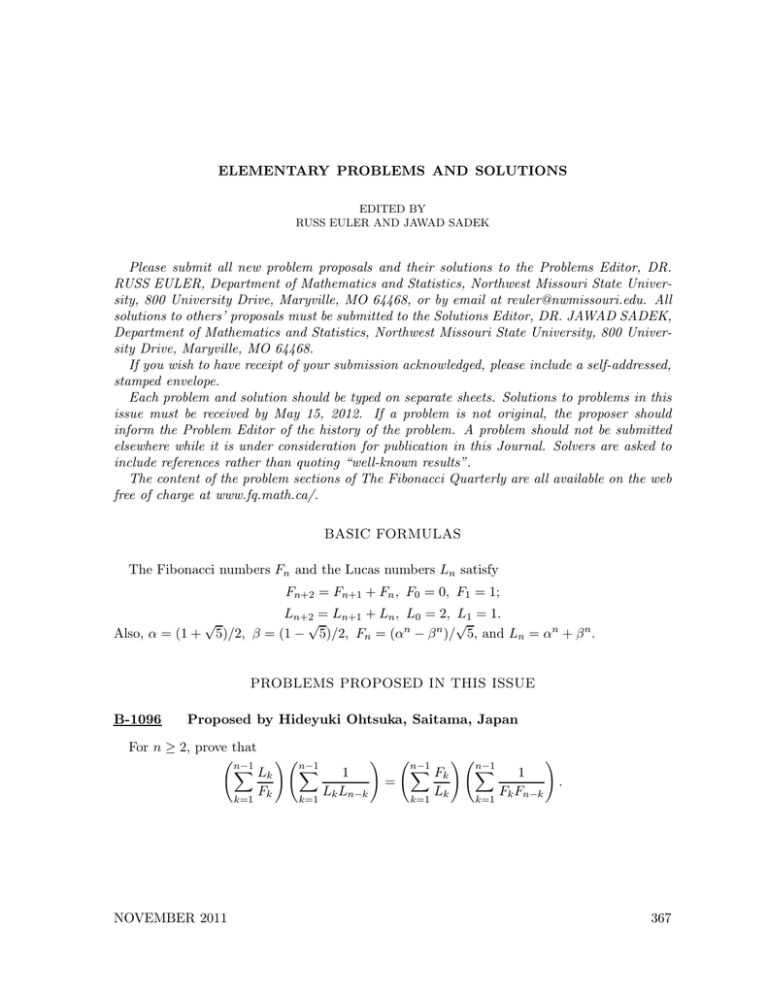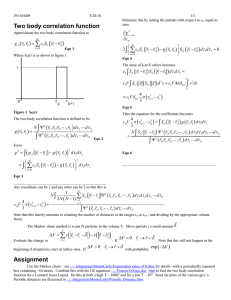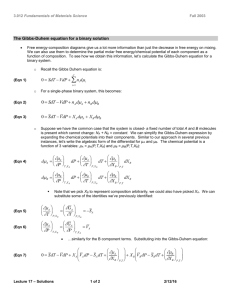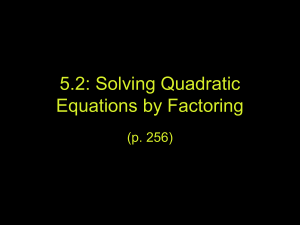ELEMENTARY PROBLEMS AND SOLUTIONS
advertisement

ELEMENTARY PROBLEMS AND SOLUTIONS
EDITED BY
RUSS EULER AND JAWAD SADEK
Please submit all new problem proposals and their solutions to the Problems Editor, DR.
RUSS EULER, Department of Mathematics and Statistics, Northwest Missouri State University, 800 University Drive, Maryville, MO 64468, or by email at reuler@nwmissouri.edu. All
solutions to others’ proposals must be submitted to the Solutions Editor, DR. JAWAD SADEK,
Department of Mathematics and Statistics, Northwest Missouri State University, 800 University Drive, Maryville, MO 64468.
If you wish to have receipt of your submission acknowledged, please include a self-addressed,
stamped envelope.
Each problem and solution should be typed on separate sheets. Solutions to problems in this
issue must be received by May 15, 2012. If a problem is not original, the proposer should
inform the Problem Editor of the history of the problem. A problem should not be submitted
elsewhere while it is under consideration for publication in this Journal. Solvers are asked to
include references rather than quoting “well-known results”.
The content of the problem sections of The Fibonacci Quarterly are all available on the web
free of charge at www.fq.math.ca/.
BASIC FORMULAS
The Fibonacci numbers Fn and the Lucas numbers Ln satisfy
Fn+2 = Fn+1 + Fn , F0 = 0, F1 = 1;
Ln+2 = Ln+1 + Ln , L0 = 2, L1 = 1.
√
√
√
Also, α = (1 + 5)/2, β = (1 − 5)/2, Fn = (αn − β n )/ 5, and Ln = αn + β n .
PROBLEMS PROPOSED IN THIS ISSUE
B-1096
Proposed by Hideyuki Ohtsuka, Saitama, Japan
For n ≥ 2, prove that
n−1
X
k=1
NOVEMBER 2011
Lk
Fk
!
n−1
X
k=1
1
Lk Ln−k
!
=
n−1
X
k=1
Fk
Lk
!
n−1
X
k=1
1
Fk Fn−k
!
.
367
THE FIBONACCI QUARTERLY
B-1097
Proposed by José Luis Dı́az-Barrero, Polytechnical University of Catalonia, Barcelona, Spain
Compute the following sum
∞
X
tan
−1
n=1
B-1098
Ln−1 (1 + Fn Fn+1 ) − Fn−1 (1 + Ln Ln+1 )
F2n−2 + (1 + Ln Ln+1 )(1 + Fn Fn+1 )
.
Proposed by Sergio Falcón and Ángel Plaza, Universidad de Las Palmas
de Gran Canaria, Spain
Let n be a positive integer. Prove that
!1/2n
n
n
2
X
Y
L
q k
(1 + L2k )
≤ Ln Ln+1 − 2.
2
1 + Lk
k=1
k=1
B-1099
Proposed by Sergio Falcón and Ángel Plaza, Universidad de Las Palmas
de Gran Canaria, Spain
For any positive integer k, the k-Fibonacci and k-Lucas sequences, {Fk,n }n∈N and {Lk,n }n∈N ,
both are defined recursively by un+1 = kun + un−1 for n ≥ 1, with respective initial conditions
Fk,0 = 0; Fk,1 = 1 and Lk,0 = 2; Lk,1 = k. Prove that
n−1
2
Fk,n
2n−1 Lk,n
n
=
k
(k + 4)
.
2i + 1
i≥0
X
n−2i 2
i n
=
k
(k + 4)
.
2i
2n+1 Fk,n+1 =
X
i≥0
n
X
n−1−2i
2
kn−i 2i Lk,i .
i
(1)
(2)
(3)
i=0
B-1100
Proposed by Sergio Falcón and Ángel Plaza, Universidad de Las Palmas
de Gran Canaria, Spain
For any positive integer k, the k-Fibonacci and k-Lucas sequences, {Fk,n }n∈N and {Lk,n }n∈N ,
both are defined recursively by un+1 = kun + un−1 for n ≥ 1, with respective initial conditions
368
VOLUME 49, NUMBER 4
ELEMENTARY PROBLEMS AND SOLUTIONS
Fk,0 = 0; Fk,1 = 1, and Lk,0 = 2; Lk,1 = k. Prove that
X 2n
Fk,2i+1 = (k2 + 4)n Fk,2n+1 .
i
i≥0
X 2n + 1
Fk,2i = (k2 + 4)n+1 Lk,2n+1 .
i
i≥0
X 2n
Lk,2i = (k2 + 4)n Lk,2n .
i
i≥0
X 2n + 1
Lk,2i = (k2 + 4)n+1 Fk,2n+1 .
i
(1)
(2)
(3)
(4)
i≥0
SOLUTIONS
An “Inverse” Relation
B-1075
Proposed by Paul S. Bruckman, Nanaimo, BC, Canada
(Vol. 48.3, August 2010)
The Fibonacci polynomials Fn (x) may be defined by the following expression:
Fn+1 (x) =
[n/2] X
k=0
n − k n−2k
x
for n = 0, 1, 2, . . . .
k
Prove the “inverse” relation:
n
x =
n
X
k=0
n
(−1)
Fn+1−2k (x) for n = 0, 1, 2, . . . .
k
k
Solution by Ángel Plaza and Sergio Falcón (jointly) Department of Mathematics,
Universidad de Las Palmas de Gran Canaria, Las Palmas G. C. Spain
The Fibonacci plynomials may also be defined recurrently by F1 (x) = 1, F2 (x) = x, and
Fn (x) = xFn−1 (x) + Fn−2 (x), if n > 2. (See [1, pp 443–446].)
Now, the proposed problem may be solved by induction. The equation is trivially true for
n = 0. Let us suppose that it is true for every integer less than or equal to n − 1, so
X
n−1
k n−1
x
=
(−1)
Fn−2k(x) .
k
k≥0
NOVEMBER 2011
369
THE FIBONACCI QUARTERLY
Now, by multiplying by x and keeping in mind that xFn−2k (x) = Fn−2k+1 (x) − Fn−2k−1 (x),
we obtain
n
X
n
k n−1
x =
(−1)
xFn−2k (x)
k
k=0
n
X
k n−1
(−1)
=
(Fn−2k+1 (x) − Fn−2k−1 (x))
k
k=0
n
X
X
k n−1
k n−1
=
Fn−2k+1 (x) −
Fn−2k−1 (x)
(−1)
(−1)
k
k
k=0
k≥0
n
X
n−1
n−1
n−1
k
(−1)
=
Fn (x) +
+
Fn−2k+1 (x)
k
k−1
0
k=1
n
X
k n
=
(−1)
Fn−2k+1 (x).
k
k=1
[1] T. Koshy, Fibonacci and Lucas Numbers with Applications, Wiley-Interscience, 2001.
Also solved by the proposer.
One of Many!
B-1077
Proposed by Hideyuki Ohtsuka, Saitama, Japan
(Vol. 48.4, November 2010)
Prove the following identity:
4
4
4
4
Fn−2
+ L4n + Fn+2
= 9(Fn−1
+ Fn4 + Fn+1
).
Solution by George A. Hisert, Berkeley, California
Let the sequence {Gn } be any sequence in which Gn+1 = Gn + Gn−1 for all n. Then
a) Gn = Gn+1 − Gn−1 ,
b) Gn+2 = Gn+1 + Gn = Gn+1 + (Gn+1 − Gn−1 ) = 2Gn+1 − Gn−1 , and
c) Gn−2 = Gn − Gn−1 = (Gn+1 − Gn−1 ) − Gn−1 = Gn+1 − 2Gn−1 .
And,
9[(Gn+1 )4 + (Gn )4 + (Gn−1 )4 ] − [(Gn+2 )4 + (Gn−2 )4 ]
= 9[(Gn+1 )4 + (Gn+1 − Gn−1 )4 + (Gn−1 )4 ] − [(2Gn+1 − Gn−1 )4 + (Gn+1 − 2Gn−1 )4 ]
= 9[(Gn+1 )4 + (Gn+1 )4 − 4(Gn+1 )3 (Gn−1 ) + 6(Gn+1 )2 (Gn−1 )2
− 4(Gn+1 )(Gn−1 )3 + (Gn−1 )4 + (Gn−1 )4 ] − [16(Gn+1 )4 − 32(Gn+1 )3 (Gn−1 )
+ 24(Gn+1 )2 (Gn−1 )2 − 8(Gn+1 )(Gn−1 )3 + (Gn−1 )4 + (Gn+1 )4
− 8(Gn+1 )3 (Gn−1 ) + 24(Gn+1 )2 (Gn−1 )2 − 32(Gn+1 )(Gn−1 )3 + 16(Gn−1 )4 ]
= (Gn+1 )4 + 4(Gn+1 )3 (Gn−1 ) + 6(Gn+1 )2 (Gn−1 )2 + 4(Gn+1 )(Gn−1 )3 + (Gn−1 )4
= (Gn+1 + Gn−1 )4 .
370
VOLUME 49, NUMBER 4
ELEMENTARY PROBLEMS AND SOLUTIONS
If Gn = Fn , then using the identity Ln = Fn+1 + Fn−1 , we obtain the desired identity. If
Gn = Ln , then using the identity 5Fn = Ln+1 + Ln−1 , we obtain the identity
9(L4n+1 + L4n + L4n−1 ) − (L4n+2 + L4n−2 ) = 625Fn4 ;
which is the result of Problem B-1058.
Note: The solver obtained a much more general result, where 4 is replaced with a positive
integer P and the coefficients 9 and 625 are adjusted accordingly.
Also solved by Brian Beasley, Paul S. Bruckman, Charles K. Cook, Kenneth
B. Davenport, G. C. Greubel, Russell J. Hendel, Pedro Henrique O. Pantoja,
Yashwant Kumar Panwar, Jaroslav Seibert, and the proposer.
Logarithmic Sum
B-1078
Proposed by José Luis Dı́az-Barrero and Miquel Grau-Sánchez, Polytechnical University of Catalonia, Barcelona, Spain
(Vol. 48.4, November 2010)
Let n be a nonnegative integer. Prove that
n
X
1
n+1
!2
ln(1 + Fk )
k=0
≤ Fn Fn+1 .
Solution by Pedro Henrique O. Pantoja (student), University of Natal-RN, Brazil
For x ≥ 0, it is well-known that x ≥ ln(x + 1). Thus,
n
n
X
X
Fk ≥
ln(1 + Fk ),
k=0
and so
n
X
Fk
k=0
Since
n
X
k=0
!2
≥
n
X
!2
ln(1 + Fk )
k=0
.
Fk2 = Fn Fn+1 , by the Cauchy-Schwarz inequality,
k=0
(n + 1)(Fn Fn+1 ) =
n
X
1
k=0
It follows that
!
1
n+1
n
X
k=0
n
X
k=0
Fk2
!
n
X
≥
k=0
!2
ln(1 + Fk )
Fk
!2
≥
n
X
k=0
!2
ln(1 + Fk )
.
≤ Fn Fn+1 .
Also solved by Paul S. Bruckman, Sergio Falcón and Ángel Plaza (jointly), G. C.
Greubel, Russell J. Hendel, Ohio Northern University Problem Solving Group,
Jaroslav Seibert, and the proposer.
NOVEMBER 2011
371
THE FIBONACCI QUARTERLY
True But Not Strong Enough!
B-1079
Proposed by Roman Witula, Silesian University of Technology, Poland
(Vol. 48.4, November 2010)
Prove or disprove the following statement:
2(−1)k−1
n
2n
2n
5 Fk−1 + Fk+1 ≡
2
(mod Lk )
(mod Lk )
if n is odd,
if n is even.
Solution by Paul S. Bruckman, Nanaimo, BC, Canada
We will establish the stronger statement:
2n
2n
+ Fk−1
) ≡ 2(−1)n(k−1)
5n (Fk+1
(mod L2k ).
(4)
Thus, the statement of the problem is true but not strong enough, since the moduli Lk may
be replaced by L2k . The starting point is the Waring Formula:
[n/2]
X n n − j n
n
A +B =
(−AB)j (A + B)n−2j .
(5)
n−j
j
j=0
This is an identity valid for all non-negative integers n, and for all A and B. Replacing n by
2n gives,
n
X
2n
2n − j
2n
2n
A +B =
(−AB)j (A + B)2n−2j .
(6)
2n − j
j
j=0
Now set A = Fk+1 , B = Fk−1 . Note that A + B = Lk . Then,
n
X
2n
2n − j
2n
2n
Fk+1 + Fk−1 =
(−Fk+1 Fk−1 )j Lk2n−2j
2n − j
j
j=0
2n
2n − n
≡
(−Fk+1 Fk−1 )n (mod L2k ).
2n − n
n
2n + F 2n } ≡ 2(−5F
n
2
k
Then 5n {Fk+1
k+1 Fk−1 ) (mod Lk ). Now 5Fk+1 Fk−1 = L2k + 3(−1) =
k−1
2n + F 2n } ≡ 2(−1)n {L2 + (−1)k }n (mod L2 ) ≡ 2(−1)n (−1)nk
L2k + (−1)k . Therefore, 5n {Fk+1
k−1
k
k
2
(mod Lk ), which is equivalent to (1). We see that 2(−1)n(k−1) = 2(−1)k−1 , if n is odd, or
equal to 2, if n is even.
Also solved by G. C. Greubel and the proposer.
The Cubic Factor
B-1080
Proposed by José Luis Dı́az-Barrero, Barcelona, Spain
(Vol. 48.4, November 2010)
Let n be a nonnegative integer. Prove that
3
2
3
2
Fn3 (2Fn2 + 5Fn+1 Fn+2 ) + Fn+1
(2Fn+1
+ 5Fn Fn+2 ) = Fn+2
(2Fn+2
− 5Fn Fn+1 ).
372
VOLUME 49, NUMBER 4
ELEMENTARY PROBLEMS AND SOLUTIONS
Solution by Jaroslav Seibert, University Paradubice, The Czech Republic
It is possible to prove the given equality for the so-called Gibonacci numbers Gn which
satisfy the recurrence Gn+2 = Gn+1 + Gn with arbitrary initial terms G0 , G1 . In fact,
G3n (2G2n + 5Gn+1 Gn+2 ) + G3n+1 (2G2n+1 + 5Gn Gn+2 ) − G3n+2 (2G2n+2 − 5Gn Gn+1 )
= G3n (2G2n + 5(Gn+2 − Gn )Gn+2 ) + (Gn+2 − Gn )3 (2(Gn+2 − Gn )2 + 5Gn Gn+2 )
− G3n+2 (2G2n+2 − 5Gn (Gn+2 − Gn ))
= 2G5n + 5G3n G2n+2 − 5G4n Gn+2 + (G3n+2 − 3Gn G2n+2 + 3G2n Gn+2 − G3n )
· (2G2n+2 + Gn Gn+2 + 2G2n ) − 2G5n+2 + 5Gn G4n+2 − 5G2n G3n+2
= 2G5n + 5G3n G2n+2 − 5G4n Gn+2 + 2G5n+2 − 5Gn G4n+2 + 5G2n G3n+2 − 5G3n G2n+2 + 5G4n Gn+2
− 2G5n − 2G5n+2 + 5Gn G4n+2 − 5G2n G3n+2 = 0.
The given identity immediately follows from this result.
Also solved by Paul S. Bruckman, Charles K. Cook, Kenneth B. Davenport, G. C.
Greubel, Russell J. Hendel, George A. Hisert, Yashwant Kumar Panwar, Ángel
Plaza, Moitland A. Rose, and the proposer.
We wish to acknowledge Kenneth B. Davenport for solving Problem B-1071.
NOVEMBER 2011
373



